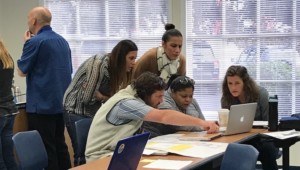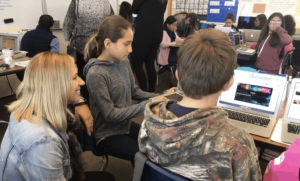5 Myths of Project-Based Learning Dissected and Debunked

Seven years ago I became a brand-new educator for the second time. Though I was in a comfortable position in a well-established school of good repute, I needed something more–though at the time, I didn’t know exactly what that was.
Then something came along at just the right moment. Our school corporation took a leap of faith by starting a Project-Based Learning (PBL) program, a courageous move that has changed the educational landscape of our community and region. I leaped along with a group of trailblazing ninth graders and a small handful of educators hungry for change. We went all-in with an educational model that many had written off as a fad.
Along the way, I’ve had the most profound professional education I’ve ever had. I’ve become an immensely better instructor than I was in my previous ten years experience; I owe this to the special dynamic that PBL both requires and creates. I learned how to work with my incredible colleagues and guide our awesome, curious and adventurous students through rich learning experiences.
It hasn’t all been pretty. We made plenty of mistakes, some resulting in students deciding it was “not a good fit” and transferring. Some staff members found the rigors of project planning completely overwhelming to the point that they either left our school or left education altogether. In the end though, the journey has left me a staunch advocate for PBL. There is no model of education that can be implemented well without the right personnel, and PBL is nothing if not demanding of competence, flexibility, open-mindedness and tolerance of failures.
But I stand, with a rapidly growing population of renegade educators, as cheerleaders for a method that works—as long as it’s done right.
There are misconceptions about PBL. Some stem from those who have tried to implement it, most likely without adequate support or training, and crashed & burned. Others come from misinformed perspectives. Below I address five of these myths from my own perspective, borne from a school and system that has successfully implemented PBL in an already successful school corporation.
1. Project-Based Learning Isn’t For Everyone
I’ve heard it many times: my son just needs a textbook. My daughter just needs to be told what to do. He can’t work with others. She just needs structure. All students have their own needs, and no one teacher or system is going to change that.
PBL doesn’t replace good teaching; it does however lend itself well to co-existing with research-based approaches. While there are most certainly a myriad of approaches that could be integrated with PBL, the one adopted by our district is Universal Design for Learning (UDL).
UDL is a framework of brain-based instruction that benefits all learners regardless of ability or learner style. It may have started as a set of strategies for providing accommodations for some, but ultimately all learners benefit.
It should be reiterated that this approach was not adopted by just our school, which is project-based, but was instead implemented on a compulsory basis by all schools in our district. It turns out that PBL in particular fits naturally (incredibly so, in fact) into two of the three categories:
- Engagement: Students that seek meaning and motivation in their learning get that from PBL because of the authentic learning experiences that its presents; and
- Action & Expression: When students are given voice and choice with how their mastery of content is manifested in final products, they can communicate their learning in many ways, instead of a prescribed and possibly one- dimensional means.
The third category, Multiple Means of Representation, is squarely in the hands of the instructor. In other words, you have to be a good teacher and PBL won’t save you if you’re not.
The point is that PBL can’t be done well without sound pedagogy, whatever that pedagogical approach is. It can provide a range of options for students to express their knowledge and skills, and can provide meaning to the learning where there perhaps was otherwise not.
2. I Won’t Be Able To Hit All Of The Standards If I Do PBL
It’s been my experience that I am no more likely to run out of time than I ever was in my previous teaching life; that is to say, covering (or, as we like to say, uncovering) the standards is challenging regardless of the setting.
My approach has always been to prioritize and clump. There may be a standard or two or three that doesn’t get due justice in my classes, but rest assured it won’t be a “power standard;” it will be the minutiae, the high-minded semantics and “pet standards” (the ones written by a person clearly with an agenda) that get slighted.
It’s true that there are processes involved in PBL that take time away from content instruction. For a given project, the “launch” and subsequent creation of groups, group contracts, etc. may take up to two days. At the end of a project, presentations may take a day or more. Reflection and celebration of successes are givens. However, meaningful project planning can result in better use of time if students are given skills in collaborating and have access to abundant, high-quality information.
If a project is well-planned, students may work in a self-paced way and avoid wasting time waiting on others to catch up with them. Benchmarks provide the opportunities for instructors to assess which groups are ready to forge on, and provided the resources are in place, students may at the least test their ability to explore on their own and never be held back.
3. PBL Is Not Preparing Students For The College Learning Environment
I couldn’t disagree more. The tendency for college work to involve more group projects is an emerging reality, but it’s the opposite end of the approach spectrum that creates more concern for me. There are those who feel lectures and traditional note taking have no place in a PBL environment. I am not among them. Never would I say that daily instruction should be done stand-and-deliver style excessively, but sometimes every student truly and honestly needs the direct instruction.
Also, if we are not asking students to practice note taking and developing attention spans suited to listening for, say, 30 minutes at a time, we are doing them a disservice. The point is that there is no single instructional approach that is quintessentially PBL. Just like with any effective instructional approach, variety matters. Immensely.
4. I’m Not Ready To Give Up All Of The Control In My Classroom
Nor am I. There is no substitute for good instruction, and those of us who do PBL do not go forth carelessly, letting the kids decide what they will learn, in what order and how they’ll be taught.
It’s quite true that one of the greatest things about PBL is that students do assume more ownership in their learning, in terms of how best to communicate and apply content in ways and contexts that are meaningful to them. It should not be forgotten though that we are the content experts, not them. It’s our job to provide structure and sequence to a project in such a way that students move logically through a set of concepts, all the time applying their new knowledge to solve the authentic problem at hand.
There is a change in dynamic that occurs as a result of a well-executed project launch, where students identify their “Need to Knows” about the problem, scenario and logistics of a project. Those Need to Knows coming from students help eliminate the perennial question of, “Why do we need to learn this?” That is, because the students express a particular Need to Know, there is an implicitly closer identification of how the content helps them solve a problem.
That being said, students generally don’t know how to sequence and structure the learning of that content. That job belongs in the hands of a qualified expert (i.e. the teacher.) Giving up that control would be a big mistake. Never—ever—should a project be allowed to veer away from content standards for any extended period (though I cannot put a hard number on that exact duration.) If it does, we run the risk of improperly preparing our students for their next steps in school and life.
As a general rule, time devoted to standards in a project is equal to the time that would otherwise be given in a traditional approach. We cannot change the reality of time and minutes, so we must pace appropriately. If a project is allowed to languish in purgatory, no one is either happy or appropriately educated in the end. This leads us to the last myth….
5. PBL Isn’t Rigorous Enough
PBL, by my personal definition, is the application of content standards to solve a real-world problem that matters. Application is and requires–by definition and necessity–higher-order thinking and problem solving skills. Content standards are viewed as the minimum proficiencies. So how is that not rigorous?
If the quantity of information that students learn takes a second seat to the quality, then I’m of the “so be it” mind. But again, it comes back to the original definition: standards are truly the minimum. My colleague Rachelle Antcliff likes to say, “I love standards; I look at them and ask, ‘Is this all I have to teach?’”
In a traditional classroom, the answer is, “Yes.” In a PBL environment, the answer is, “Um, no. They have to learn the standards, apply them to the authentic context to solve a problem, communicate their knowledge to community partners in a number of ways, while working together as a team, struggling with decisions and meet numerous deadlines along the way.”
So, Am I Biased In My Dispelling Of These “PBL Myths?”
Perhaps, but only because seven years of experience has taught me what PBL can be, should be and will be for the rest of my educational career. I know that PBL is a daunting change in mindset to undergo because I did it and have seen many others do so as well.
The best advice I can offer is (to borrow from Boromir from “The Lord of the Rings” and countless internet memes) “One does not simply implement PBL without the proper training and support.”
Learn from the people doing PBL well and copy what they do. Ask them for help. Seek feedback as often as possible from and as many different types of people as possible. And don’t give up, even when it’s get hard–and it’s often hard.
This blog is part of “It’s a Project-Based World” series. To learn more and contribute a guest post for the series, see the Project-Based World page. Join in the conversation at #projectbased.
For more, see:
- It’s a Project-Based World
- Is it a Project or an Activity? Project-Based Learning and its Cousins
- 3 Elements of Deeper Project-Based Learning
Stay in-the-know with all things EdTech and innovations in learning by signing up to receive the weekly Smart Update. This post includes mentions of a Getting Smart partner. For a full list of partners, affiliate organizations and all other disclosures please see our Partner page.






Randy Fieldjng
This is an important topic, and Andrew Larson goes a long way to help practitioners understand how PBL works. There are two assumptions in item 4 which he presents as truths, while my experience holds otherwise.
"We are the content experts."
This was not the case when I went to school, nor is it the case today as I mentor dozens of young adults (I am the cofounder and Chairman of Fielding Nair International, a global Architecture and Education firm). While I was in Jr High and High School, I generated far more discussion in class by bringing up readings and news sources outside of my teacher's expereience than their prescribed reading did. Most of the teachers thanked me for this. In high school, I got a pass to get out of school at noon, so that I could take charge of my own learning.
"Students generally don’t know how to sequence and structure the learning of that content. That job belongs in the hands of a qualified expert (i.e. the teacher.) Giving up that control would be a big mistake. Never—ever—should a project be allowed to veer away from content standards."
This is so wrong in my experience! My art teacher in high school had no way of effectively sequencing my education--I was visiting galleries, reading and drawing from life out side of class at a level that was beyond his understanding. Getting out of my way and letting me pursue my own path was the best thing he could do for me. As I mentor various individuals and teams today, I constantly find that young adults with out any experience surprise me with great ideas that I had never thought about. Giving up control, while fostering an atmosphere of creativity, collaboration, and hard work, is the best way I can support their learning and work.
John Sole
Regarding the 4th "Myth" I think, respectfully, that you're both presenting your alternatives in too stark terms. Randy, your talents and gifts an educator, a student, and as an educational facilities planner are remarkable and unique. Your capacity for wonder and to quantify disparate data points into teaching and learning spaces that work for the specific needs of your clients across the globe are some of the reasons FNI is a leader in creating superior physical educational places that work.
Andrew, your unequivocal stance on "never, ever" losing sight of the content standards would, almost by definition, alienate a free-spirited student like Randy and would most likely turn him into a real pain in the butt! One of the foundational keystones of PBL is for students to take ownership of their educational processes. If, by your standards, you had a Randy Fielding in your class who apparently took the idea of "ownership" to the nth degree as a student, I could see the potential for a real adversarial relationship.
Perhaps there's a 3rd way. Like you, Andrew, I believe that there needs to be parameters set by the teacher. Within those parameters, students can exercise a great deal of freedom make hypotheses, fail, try something new, etc towards solutions of a standards aligned Project, and in the process, LEARN. Like you, Randy, I believe that students should be free to arrive at Project Based solutions to real-world problems that will prepare them to be successful, literate leaders in a global environment.
For better or worse, "we" as teachers are the content experts, Randy, and within those aforementioned parameters even a free soul like Randy Fielding, student, should be able to flourish.
Hope I didn't stray too far afield.